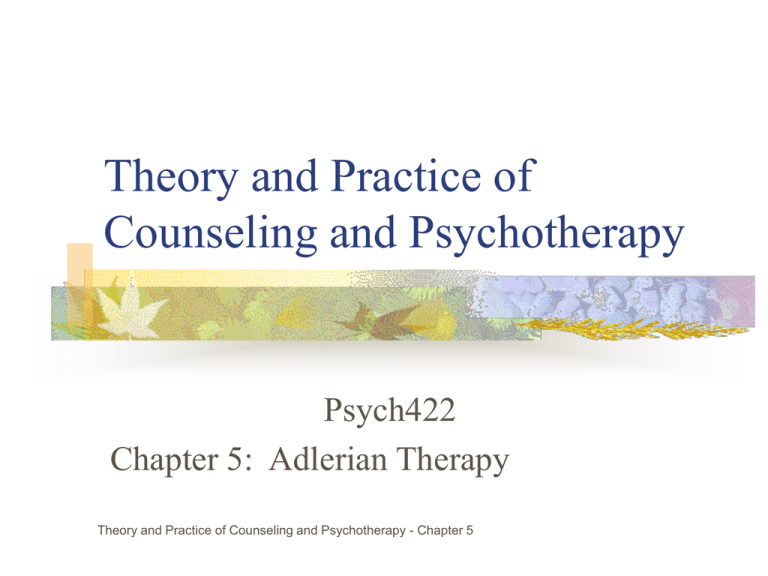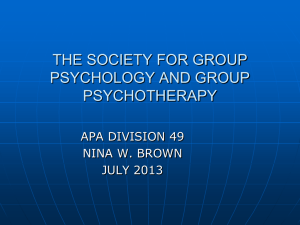Theory and Practice of Counseling and Psychotherapy
advertisement

Theory and Practice of Counseling and Psychotherapy Psych422 Chapter 5: Adlerian Therapy Theory and Practice of Counseling and Psychotherapy - Chapter 5 Questions What do you think about Alderian approach? What do you know about Alderian approach? View of Human Nature Stress choice and responsibility, meaning in life, and the striving for success, completion, and perfection. Focuson inferiority feelings---motivate to strive for success (superiority) Focus on subjective experiences Theory and Practice of Counseling and Psychotherapy - Chapter 5 Alfred Adler’s Individual Psychology A phenomenological approach Social interest is stressed Birth order and sibling relationships Therapy as teaching, informing and encouraging Basic mistakes in the client’s private logic The therapeutic relationship — a collaborative partnership Theory and Practice of Counseling and Psychotherapy - Chapter 5 The Phenomenological Approach Adlerians attempt to view the world from the client’s subjective frame of reference How life is in reality is less important than how the individual believes life to be It is not the childhood experiences that are crucial – it is our present interpretation of these events Unconscious instincts and our past do not determine our behavior Theory and Practice of Counseling and Psychotherapy - Chapter 5 Social Interest Adler’s most significant and distinctive concept Social interest: a sense of identification and empathy with others. Community feeling: a sense of social connectedness Happiness and success are largely related to social connectedness Many problems are related to the fear of not being accepted by the groups we values. Then, anxiety is the result. Theory and Practice of Counseling and Psychotherapy - Chapter 5 Birth Order What are the unique characteristics of each birth order? 1) Oldest child – 2) Second of only two – 3) Middle – 4) Youngest – 5) Only child – Birth Order Adler’s five psychological positions: 1) Oldest child – receives more attention, spoiled, center of attention 2) Second of only two – behaves as if in a race, often opposite to first child 3) Middle – often feels squeezed out 4) Youngest – the baby 5) Only – does not learn to share or cooperate with other children, learns to deal with adults Theory and Practice of Counseling and Psychotherapy - Chapter 5 Therapeutic Goals Collaborative relationship Develop a sense of belonging. Encouragement is the most powerful method available for changing a person’s beliefs Helps build self-confidence and stimulates courage Discouragement is the basic condition that prevents people from functioning Clients are encouraged to recognize that they have the power to choose and to act differently Theory and Practice of Counseling and Psychotherapy - Chapter 5 Therapist’s function and role Help to identify major mistakes Lack of confidence, mistrust…. Gathering information through family constellation, early recollections, or lifestyle assessment. Understanding, challenging, and changing their life story and develop an alternative story Theory and Practice of Counseling and Psychotherapy - Chapter 5 Client’s Experience in Therapy Do not recognize the basic mistake or private logic Views of self, others, and life based on a person’s lifestyle Help to discover the motivation of basic mistake Do not know what to do differently Fear of letting go the old patterns for unpredictable new alternative options Cling to old patterns even though it is unsuccessful Theory and Practice of Counseling and Psychotherapy - Chapter 5 Relationship b/w Therapist and Client Cooperation, mutual trust, respect Making a contract with clients Detail what they (clients) want How they plan What is preventing them from reaching goals How to change unproductive behavior into constructive behavior How to make use of their strengths Theory and Practice of Counseling and Psychotherapy - Chapter 5 Therapeutic Techniques and Procedures 1. Establishing the relationship Collaborative relationship, deep caring and involvement Identity personal issues Focus on person not the problem Increase the awareness of strengths Focus on subjective experiences and core patterns Theory and Practice of Counseling and Psychotherapy - Chapter 5 Therapeutic Techniques and Procedures 2. Exploring the individual’s dynamics Client tells his or her story; clients as experts The motivation behind coping strategies Therapist is like a “lifestyle investigator” Family Constellation Early Recollections Personality priorities Integration and summary Theory and Practice of Counseling and Psychotherapy - Chapter 5 Family constellation Who are the favorite child? What was your father’s relationship with thie children? Your mother’s? Which child was most life your father? Your mother? In what respects? Who among the siblings was most different from you? In What ways? Who among the siblings was most like you? In what ways? What were you like as child? How did your parents get along? In what did they both agree? How did they handle disagreements? How did they discipline the children? Early recollections Three earliest memory What part does the person take in the memory? Is the person an observer or a participant? Who else is in the memory? What position do others take in relation to the person? What are the dominant themes and overall patterns of the memories? What feelings are expressed in the memories? Why does the person choose to remember this event? What is the person trying to convey? Personality priorities Superiority (or significance) Control Comfort Pleasing Integration and summary Five basic mistake Overgeneralizations Impossible goals Misperceptions of life and life’s demands Minimization or denial of one’s basic worth Faulty values Therapeutic Techniques and Procedures 3. Encouraging self-understanding and insight Insight: an understanding of motivations that operate in a client’s life Disclosure and interpretations are techniques that facilitate the process of gaining insight. Therapeutic Techniques and Procedures 4. Helping with reorientation Putting insights into practice Useful side of life Sense of belonging and being valued Useless side of life Withdrawal from life tasks or self-protection Therapeutic Techniques and Procedures 4. Helping with reorientation Encouragement No intervention is more important than encouragement Help clients identify self-defeating patterns Make use of assets, strengths, and resources Search for new possibilities Making a difference Areas of implications Education Parent education Marriage counseling Family counseling Group work Adlerian therapy From multicultural perspectives Contributions to multicultural counseling Social equality, sensitive to cultural and gender issues Focus on a person in a social context Social interests, sense of belonging, cooperation (instead of competition) Focus on family Subjective experience (unique world of a person) Adlerian therapy From multicultural perspectives Limitations to multicultural counseling Self as the locus of change and responsibility may be problematic for some clients Detailed explorations of one’s early family experiences may violate some cultural value Some clients may expect therapists to provide them with solutions to the problems Summary and evaluation Contributions of Adlerian approach Limitations of Adlerian approach




